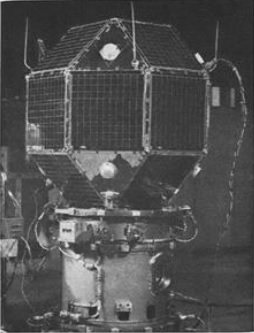The United States Air Force commissioned the Massachusetts Institute of Technology’s Lincoln Laboratory to design and build a series of satellites, known as Lincoln Experimental Satellite (LES), that would test both devices and techniques for satellite communication. The stated goal was to increase the downlink transmission capabilities of small satellites. The development phase of the program ran from 1965 to 1976 but the last satellite developed, LES-9, continued to transmit data for 44 years until it was decommissioned in the year 2020.

The first satellite the Lincoln Laboratory developed was the LES-1. It was designed to test a solid-state X-band transmitter while in orbit above the Earth. A ground-based mobile receiver was also part of the test package.
The LES-1 was a 26-sided polyhedron, with eighteen square faces and eight triangular faces. Also known as a rhombicuboctahedron, a small rhombicuboctahedron, or an Archimedean solid, if you really must know. It had a diameter of 61 cm (24 inches) and a mass of 31 kg (68 lbs.). The square faces were covered with 2,376 solar cells generating a minimum of 26 W in sunlight. The eight triangular faces held Earth and Sun sensors and eight semi-directional horn antennas.

The satellite was launched on a Titan 3A rocket which was a modified two-stage Titan 2 ICBM with a third stage added. The rocket lifted off from Kennedy Space Center on 11 February 1965 and the first two stages performed their mission successfully. The third stage after its first burn placed the satellite into its planned 185-kilometer (115 mile) orbit. The second burn of the third stage moved the satellite into a 2,777 by 2806 kilometer (1726 by 1744 miles) slightly elliptical orbit. At this point, the satellite was deployed with a destination of 18,500-kilometer (11495 mile) apogee orbit. Because of a malfunction the smaller attached satellite rocket didn’t fire, and the satellite remained in its 2,777-kilometer orbit. Despite this failure, the project was still able to collect some useful data, but the satellite was spinning out of control making continued operations difficult. The LES 1 was shut down in 1967.
On 18 December 2012, the satellite woke up after 46 years of silence. A signal from LES 1 was detected in North Cornwall, England by an amateur radio operator. It is believed that a short developed in the satellite which allowed its power system to reach the transmitter directly. The signal being transmitted is believed to be a test tone but because the satellite is tumbling it sounds ghostly and garbled.
As of 2022 the satellite is still transmitting. It is now referred to as a zombie satellite.
References and Readings:
Abandoned in Space in 1967, a U.S. Satellite Started Transmitting Again in 2013. By Stefan Andrews. The Vintage News. 2017
Zombie Satellites: The Tale of Lincoln Experimental Satellite 1. By Andrew LePage. Drew Ex Machina. 2022
NSSDCA/COSPAR ID: 1965-008C. By Unknown. NASA. Date Unknown
FootNotes:
FootNoteA: LES 1 with Kick Motor. U.S. Air Force photo. Public Domain
FootNoteB: Launch of the first Titan IIIA from Pad 20, 1 Sept 1964. U.S. Air Force photo. Public Domain.